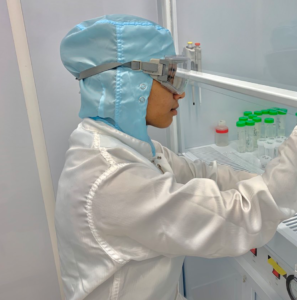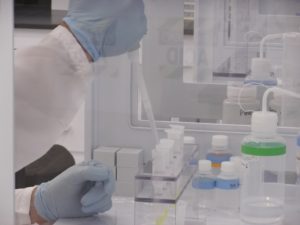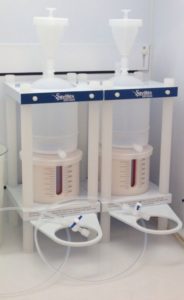The I sotope Cosmochemistry and Geochronology Laboratory (ICGL) is one of only a few isotope laboratories in the U.S. dedicated to the analysis of meteorites. It consists of a 1,000 sq. ft. clean chemistry laboratory and a neighboring mass spectrometer facility.
sotope Cosmochemistry and Geochronology Laboratory (ICGL) is one of only a few isotope laboratories in the U.S. dedicated to the analysis of meteorites. It consists of a 1,000 sq. ft. clean chemistry laboratory and a neighboring mass spectrometer facility.
Commonly known examples include 12C, 13C and 14C, the three naturally occurring isotopes of carbon, and 235U and 238U, the two naturally occuring isotopes of uranium (which are both radioactive).
 We measure the abundance of the radiogenic "daughter" products of short- (e.g., 26Al, 60Fe, 146Sm) and long-lived radioactive isotopes (e.g., 147Sm, 176Lu, 238U), relative to stable, non-radiogenic isotopes of the same elements to determine the age of a mineral or rock.
We measure the abundance of the radiogenic "daughter" products of short- (e.g., 26Al, 60Fe, 146Sm) and long-lived radioactive isotopes (e.g., 147Sm, 176Lu, 238U), relative to stable, non-radiogenic isotopes of the same elements to determine the age of a mineral or rock.
We also measure the mass-dependent fractionation of light from heavy isotopes as a tracer of processes that may have occurred during the early history of the Solar System, such as evaporation, condensation, and alteration processes.
The ratio of an isotope produced by radioactive decay to one that is non-radiogenic (i.e., not produced by radioactive decay) and not radioactive itself, can be used to determine the age of a sample. More precisely, it allows the time elapsed since the sample was last isotopically homogeneous (as in a magma, for example) to be determined.
Ultra-clean conditions are essential to the functioning of the ICGL. These are provided, first, by a dedicated air handler supplying class 1000 air, meaning the air contains fewer than 1000 particles per cubic foot (normal air contains millions of particles per cubic foot).
 The lab also contains over 30 linear feet of ultra-clean laminar flow cabinets and hoods providing class 10 and better conditions. These are used to perform preparation and chemical processing of meteorite samples.
The lab also contains over 30 linear feet of ultra-clean laminar flow cabinets and hoods providing class 10 and better conditions. These are used to perform preparation and chemical processing of meteorite samples.
In addition, water used in our laboratory undergoes three different purification steps to bring the background concentrations of most elements down to the parts-per-quadrillion level (a quadrillion is 1,000,000,000,000,000).
Lastly, the acids we use to dissolve meteorites and for chemical processing of samples are distilled multiple times and contain only a few parts per trillion of most elements.
All of these precautions are necessary to make sure that data we produce are free of artifacts caused by terrestrial contamination in the laboratory.
All photos © ASU/ICGL.



